Last time we fashioned a barren oak tree using twisted wire for the main trunk and seamoss for the ramifications. We went on to add some structure to the bark carving a characteristic pattern in a layer of wood-filler. Painted up, the tree looks the part for a winter scenario. However, adding some fall foliage and critters we can add some colour and life to it before winter arrives.
I will briefly outline how to paint the squirrels, how to finish the autumn themed base and finally how to attach the foliage. As always, some facts about squirrels, materials required and step-by-step instructions will be provided.
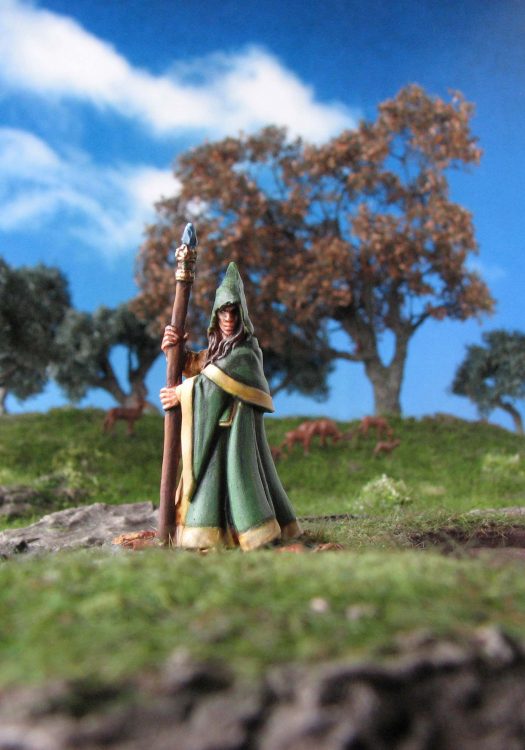
Facts about squirrels
While different species of squirrels exist, differing in size, fur colour and behaviour, I decided to go for the red squirrel (Sciurus Vulgaris) which is endemic in Eurasia. Coat colours range within the species from black to red, while the fur on the underbelly is always white or cream coloured.
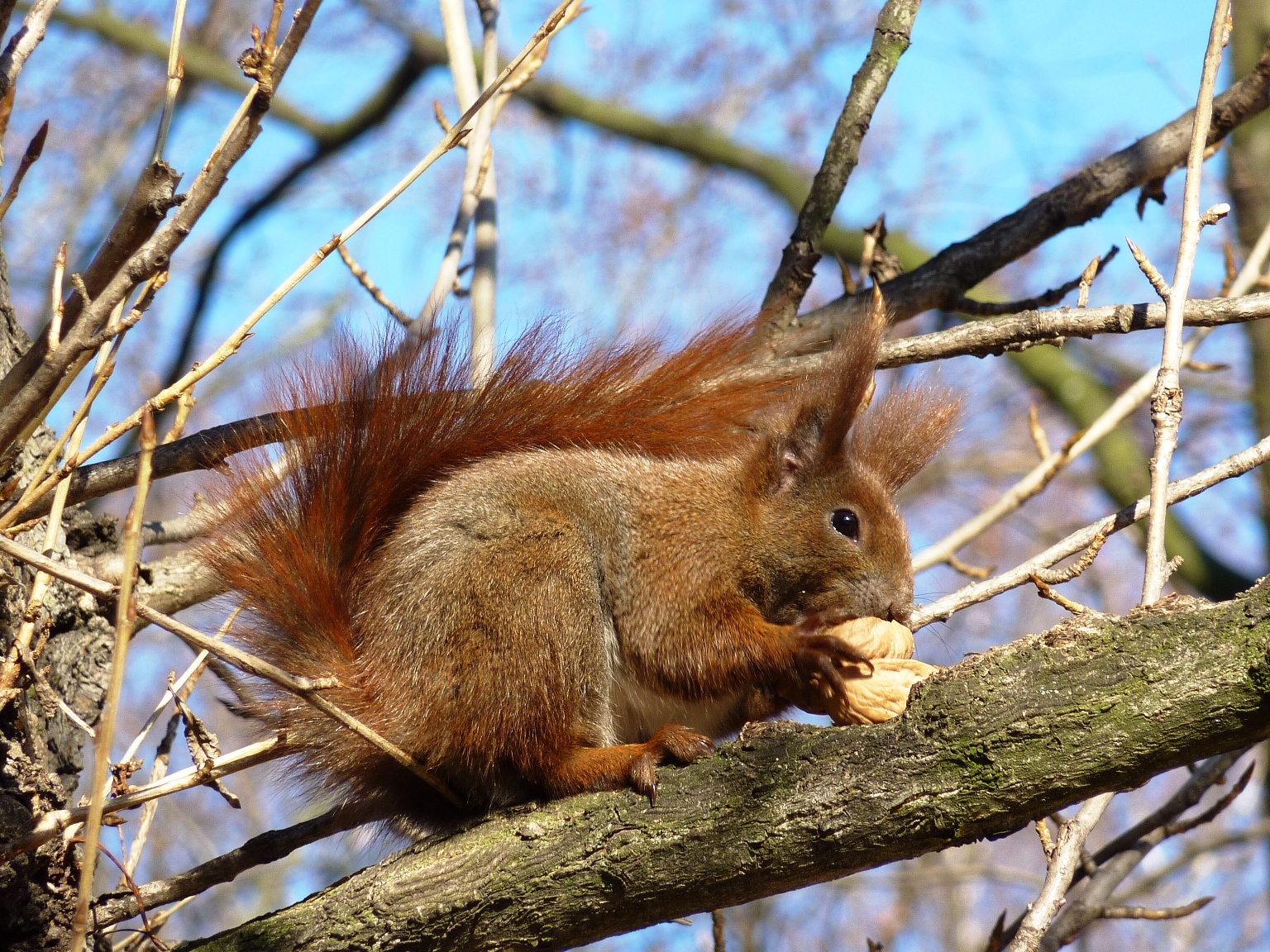
Outside the mating season and especially in winter the otherwise solitary red squirrel is known to inhabit a drey with other squirrels to keep warm.
Keeping these characteristics in mind, I wanted to depict two squirrels foraging on the tree. Both with a dark brown coat colour. The squirrel miniatures can be sourced from the very useful Busch Kleintierset, which features not only squirrels, but all kinds of small animals: Owls, rabbits, mice, fish, butterflies, lizards and so on. An alternative to Busch are the offerings by Minisocles. Their squirrels are larger (proper 28mm and not 1:87 like the Busch set) and even feature road kill. We won’t need the latter, but their squirrels are really nice and detailed.
What you need
Base
- A piece of 1mm thick plastic card/styrene sheet for the base.
- A selection of different tufts to decorate the base.
- Dried basil and a selection of autumn colours to depict fallen leaves on the ground.
- Acrylic gel, fine and coarse sand to depict the groundwork.
- Brown pigment to sprinkle on the groundwork.
- Different sized brushes.
- Wood glue.
Squirrels
- Two squirrels from the Busch Kleintierset or any other supplier.
- Acrylic paints: Brown, red and white to paint the squirrels.
Foliage
- MiniNatur late fall oak foliage net. The tree is rather big so you might need a good portion of a medium-sized bag, which costs 20 Euro. So while not the cheapest option out there, it is hard to find a replacement that will look as convincing. For the tree pictured I used half a pack.
- A pair of small scissors to shape the foliage nets.
- Super glue to attach the nets to the armature. Get some fast setting stuff.
How you do it
Cut the styrene sheet to size and attach the tree with some super glue to it. Make sure the base is big enough so that the tree does not fall over. Getting the tree to stand properly on the base is sometimes a bit of a fiddly undertaking. If some wire is in the way just cut it off. You can also gently bend the roots to shape.
Forest base
Mix some matte acrylic gel, fine and coarse sand as well as brown paint to a thick paste. Spread the paste all over the base and fill in any gaps with a fine brush. Sprinkle some brown pigment powder over the still wet paste and let fully dry. Remove any excess pigment.
In the meantime put some of the dried basil in a small container and add some red-brown paint. Mix untill the basil is coloured evenly. Rinse and repeat with a yellow tone, dark brown tone and orange tone.
While the fall leaves dry prepare some tufts. First give them a spray with matt varnish to reduce shine. Then use some brown wash (I recommend Vallejo Umbra Shade) and let it run down into the centre of the tufts to add some colour variation.
As soon as the groundwork is dry, glue on the tufts. Finally add more dilute PVA glue in some places and sprinkle the leave mix over it.
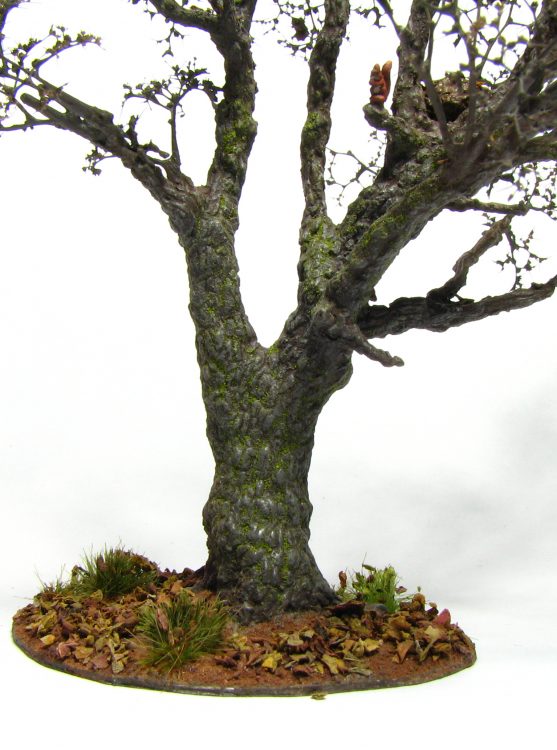
Squirrels
It is easier to paint the small squirrels while still on the sprue. Basecoat the squirrels, paint the underbelly off-white and the fur brown-red. Apply Vallejo Umbra shade.
The Busch squirrels have just enough detail to pick out the different body parts and will reward some highlights to enhance contrast.
Cut the squirrels off the sprue and attach them to a suitable branch with some superglue.
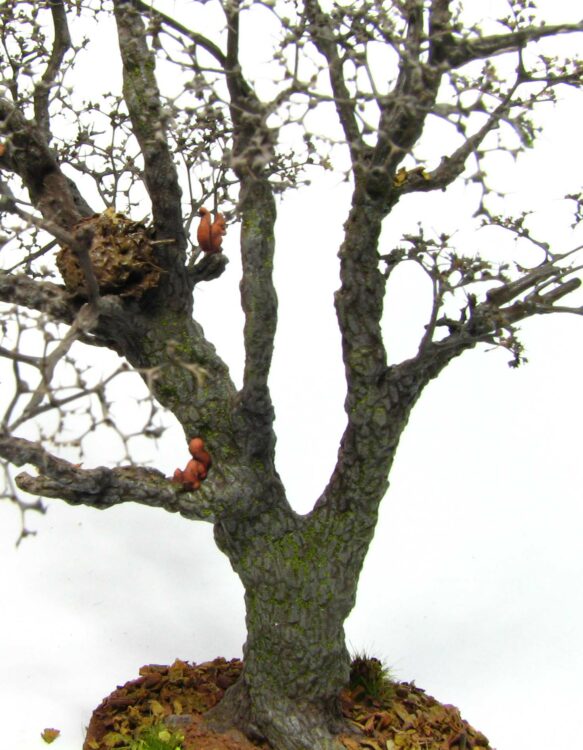
Attaching the foliage
Cut the foliage nets to size and attach them with super glue to the fine outer ramifications. Make sure the pieces are not too rectangular, pull them slightly apart and use smaller pieces rather than large ones. The idea is to achieve a look as if the tree would have shed some leaves already.
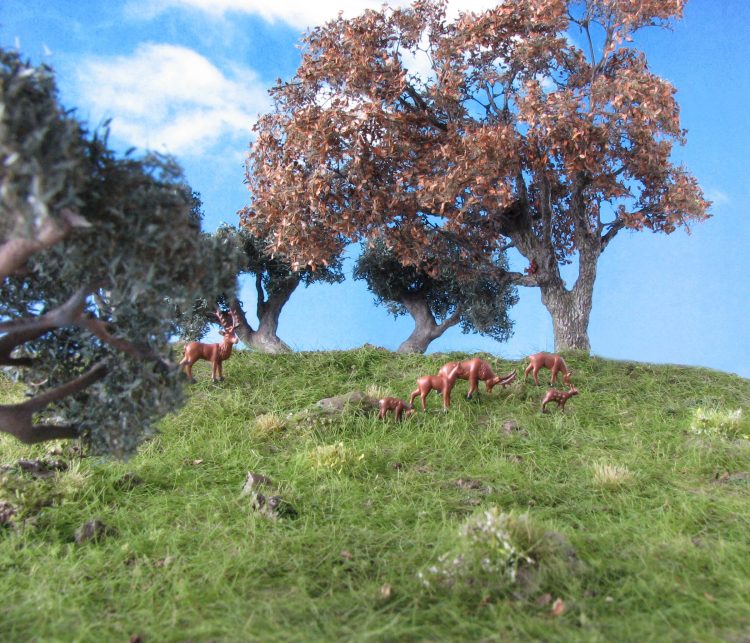
I hope this second part of the tutorial was of interest and inspires you to add some critters to your own projects. Please comment below if you have suggestions or would like to share your own techniques to achieve realistic trees.
Ugh, the detail! It kills me. 😛 Squirrels, man. Squirrels. I think you need to make a tree with a woodpecker, or a hummingbird. Not sure which species of tree is best for each of those, but it would be a neat detail!
I see I did not reply to this one. Shame on me! I already have some ideas about adding birds to my trees and a nice bird’s nest complete with eggs. I still have to figure out where birds place their nests in a tree, however.
Your trees are absolutely brilliant indeed. Looks almost more real than the ones I see from the window. About sea moss, I have never really looked into that before, but how would it work if whole thing is scaled down somewhat? Eg. for 6mm. Foliage may be a bit too coarse, but perhaps some really fine one is available.
I am still battling with 6mm scale individual trees and forest among other things. I know of the very fine design of wargame artist where clump foliage canopy comes off but haven’t tested that yet.
Thank you very much for your comment! Glad you like them.
I could see seamoss working easily for 6mm, but keep in mind that on their own the twigs are rather fragile. Another idea could be to use copper wire to make really small, filigrane trees and use MiniNatur’s range of N-scale 1:160 foliage nets.
The problem with clump foliage on this scale might be that it is too coarse to properly represent leaves.
Your putting our trees to shame. The only wildlife in my trees are house spiders 🙂 Excellent work as usual.
Thank you very much! Excellent idea with the spiders ;). If I can find some that match scale wise that would make a cool Fantasy forest
Putting squirrels in the trees? That’s a bit mad and a bit brilliant! Looks absolutely fantastic.
Thank you, much obliged! Wait until I finished the next tree with a bird nest complete with eggs ;).
Wow looks really good in the end result. I need to try some trees soon but I doubt they’ll come out this nice.
Thanks! It seems with trees the more time you invest, the better they get, so it is really more a matter of how far you would like to go (or how crazy you are). I think what really makes them realistic is the bark texture and the foliage. If you concentrate on these elements they should look good. I will be very interested in your take on it.
Another great tutorial, with great photos and a fantastic result! Is that a Bones model in the final image?
Thank you very much for your comment. I am glad the finished tree is well received. The mage is indeed a Bones Miniature: Anirion Woodelf Wizard. You can find a review of the miniature in the review section.